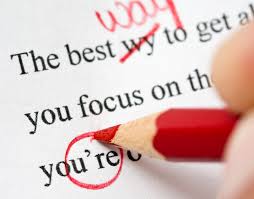5 proofreading tips every teacher and student should know.
/Proofreading is a skill which generally gets tougher the longer you write. Proofreading does not solely consist of spell checking or computerized analysis of grammar. It is a skill that must be performed by someone who is in a clear state of mind and is aware of the common pitfalls of poor writing.
Here are five tips that will assist teachers and students in becoming a better proof-reader.
Clear your mind and concentrate on the task at hand: Before you start ensure you have an open and receptive state of mind. Remove yourself from any distractions such as music, distracting digital devices and set yourself a time frame for the task at hand. For example for the next 10 minutes this is my prime task. After that stand up, change your mental and physical state for a moment.
Get a print out if possible: I know we try and advocate the paperless office as much as possible, but you will have a different experience reading a printout than reading from the screen you have been staring at for the last two hours. It only needs to happen once, it might be the first or last proofread. That’s up to you but if you value the process it is a cheap price to pay. And always remember to recycle when you are done.
Always read for meaning first: Ask yourself if I am reading this as a complete novice does it make sense? Is the language audience appropriate? Spelling, punctuation and grammar will come next but don’t waste your time editing a grammatically perfect text that simply doesn’t make sense in the first place. It’s tough but try not to get side-tracked just yet.
Homonyms, contractions and apostrophes are your enemy. Assuming you can spell, or access a decent spell checker at the least these three elements of writing will be the most deceptive be aware of the following.
Homonyms are words which share the same spelling or pronunciation, but have different meanings. If you confuse ‘bare’ with ‘bear’ you might make your audience grizzle.
Don’t let contractions get you down. ‘Your’ and ‘You’re’ are often confused be aware of these.
Apostrophes should never be used to create plurals. Be consciously aware of seeking them out.
Get a second set of eyes: No matter how many times you read a piece of text it is easy to misread what you want to see, not exactly what is in front of you. Get a friend or someone else to read your text and get them involved later in the process than earlier. As soon as they read a heap of early mistakes they will create a negative approach to the rest of the paper.
I’d love to hear if you have any other tips.












